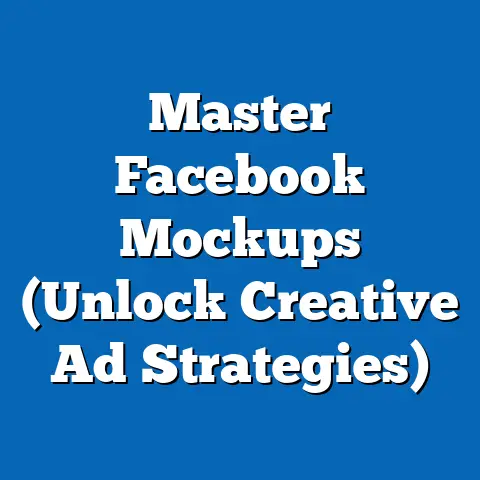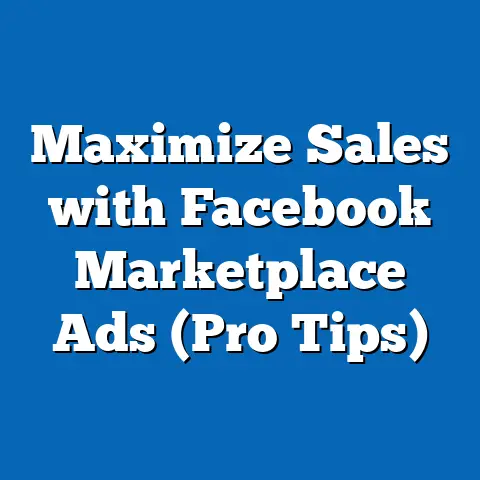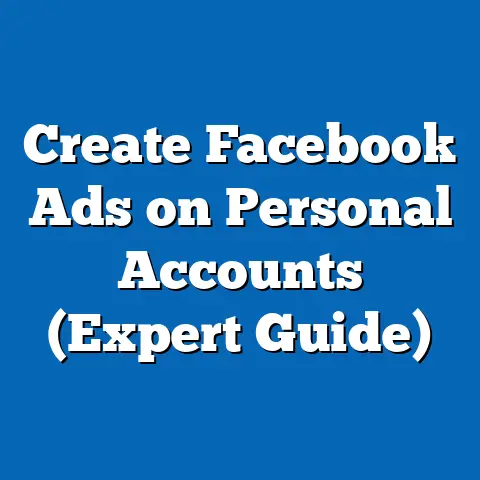Sell Courses Effectively (Proven Facebook Strategy)
Have you ever looked at someone expertly crafting a gourmet meal, capturing stunning photographs, or leading an invigorating fitness class and thought, “I wish I could do that?” We all have hobbies and passions that ignite our interest. I know I do! From woodworking to astrophotography, I’m constantly fascinated by the skills and knowledge others possess. And here’s the thing: those skills and knowledge are incredibly valuable. In today’s digital age, turning a passion into a profitable online course is more accessible than ever, and Facebook advertising is the key to unlocking that potential.
The online learning market is booming. People are hungry for knowledge and eager to learn new skills from the comfort of their own homes. Whether it’s mastering the art of sourdough baking, learning how to code, or becoming a certified yoga instructor, online courses offer a convenient and effective way to pursue personal and professional growth. I’ve seen firsthand how individuals have transformed their lives by sharing their expertise through online courses, and Facebook has been instrumental in their success.
In this guide, I’ll walk you through a proven Facebook strategy for selling your courses effectively. Whether you’re an expert in a niche hobby or a seasoned professional looking to expand your reach, I’ll show you how to leverage the power of Facebook advertising to connect with your ideal students and build a thriving online course business.
Section 1: Understanding Your Audience
Before diving into the technical aspects of Facebook advertising, it’s crucial to understand who you’re trying to reach. I always tell my clients, “You can’t sell to everyone, so don’t try to!” Defining your target audience is the foundation of any successful marketing campaign.
Think about it this way: if you’re selling a course on landscape photography, you wouldn’t target teenagers interested in video games. You’d want to focus on adults who enjoy hiking, travel, and outdoor activities. To effectively target your audience, consider the following factors:
- Demographic Factors: This includes age, gender, location, education level, and income. For example, if your course is aimed at retirees looking to learn a new skill, you’ll want to target an older demographic with a comfortable disposable income.
- Psychographic Factors: This delves deeper into your audience’s interests, values, lifestyle, and personality. What are their pain points? What are their aspirations? What motivates them to learn? Understanding these factors will help you craft compelling ad copy that resonates with their needs and desires.
- Hobbies and Interests: This is where the “hobby” aspect comes into play. What specific hobbies are your potential students interested in? Are they passionate about gardening, woodworking, painting, or playing a musical instrument? Facebook’s targeting options allow you to reach users based on their declared interests, making it easier to connect with your ideal students.
Creating Customer Personas:
One of the most effective ways to understand your audience is to create customer personas. These are fictional representations of your ideal students, based on research and data. Give your personas names, ages, occupations, and backstories. Describe their goals, challenges, and motivations.
For example, let’s say you’re selling a course on gourmet cooking. You might create a persona named “Sarah,” a 35-year-old working professional who loves to cook but struggles to find the time to create elaborate meals. She’s looking for a course that will teach her how to prepare delicious and healthy meals quickly and easily. By creating a detailed persona like Sarah, you can better understand her needs and craft ad copy that speaks directly to her pain points.
I remember working with a client who was selling a course on calligraphy. Initially, they were targeting a broad audience, and their results were underwhelming. After we worked together to create detailed customer personas, focusing on individuals interested in journaling, wedding invitations, and personalized gifts, their conversion rates skyrocketed. Understanding your audience is the key to unlocking the power of Facebook advertising.
Key Takeaway: Define your target audience by considering demographic, psychographic, and hobby-related factors. Create customer personas to gain a deeper understanding of their needs and desires.
Section 2: Crafting an Irresistible Offer
Now that you understand your audience, it’s time to craft an offer that they can’t refuse. I’ve learned that even the best targeting in the world won’t matter if your course offer isn’t compelling. Your course needs to provide clear value and address the specific needs of your target audience.
Here are some key elements of an attractive course offer:
- Clear Outcomes and Benefits: What will students gain by taking your course? Will they learn a new skill? Will they improve their career prospects? Will they achieve a personal goal? Clearly communicate the outcomes and benefits of your course in your ad copy and landing page. For example, instead of saying “Learn photography,” say “Master the art of landscape photography and capture breathtaking images that will amaze your friends and family.”
- Competitive Pricing Strategies: Pricing is a crucial factor in attracting students. Research your competitors and see what they’re charging for similar courses. Consider offering a lower price to attract initial students or offering a premium price for a more comprehensive course with additional features. I’ve found that offering different pricing tiers can be a great way to cater to different budgets and needs.
- Bonuses and Additional Resources: Adding bonuses and additional resources can significantly enhance the value of your course. Consider offering downloadable materials, such as checklists, templates, or cheat sheets. You could also offer access to a private community where students can connect with each other and ask questions. These extras can make your course more attractive and justify a higher price point.
- Guarantee: Offering a satisfaction guarantee can alleviate any concerns that potential students may have about investing in your course. A money-back guarantee shows that you’re confident in the quality of your course and willing to stand behind your product.
Framing the Offer for Hobbyists:
When selling courses to hobbyists, it’s important to frame the offer in a way that resonates with their passion. Emphasize how your course can help them:
- Turn their passion into a side hustle: Many hobbyists dream of monetizing their skills and knowledge. Show them how your course can help them turn their passion into a profitable side business.
- Improve their skills and techniques: Hobbyists are always looking for ways to improve their craft. Highlight how your course can help them master new techniques and take their skills to the next level.
- Connect with a community of like-minded individuals: Many hobbyists enjoy connecting with others who share their passion. Emphasize the community aspect of your course and how it can provide a supportive and collaborative learning environment.
I once helped a client who was selling a course on knitting. Initially, they were struggling to attract students. After we reframed the offer to emphasize the therapeutic benefits of knitting and the opportunity to create beautiful, handmade gifts, their sales increased dramatically. By understanding the motivations and desires of your target audience, you can craft an offer that they simply can’t resist.
Key Takeaway: Craft an irresistible offer by clearly communicating the outcomes and benefits of your course, offering competitive pricing, adding bonuses and additional resources, and framing the offer in a way that resonates with hobbyists.
Section 3: Creating Compelling Facebook Ads
Now comes the exciting part: creating Facebook ads that convert! I’ve spent years experimenting with different ad formats, copy styles, and visuals, and I’ve learned that there’s no one-size-fits-all approach. However, there are some key principles that can help you create effective Facebook ads.
- Visuals: High-quality visuals are essential for capturing attention on Facebook. Use eye-catching images or videos that showcase your course content, the instructor’s expertise, or the results that students can achieve. If you’re selling a course on cooking, use mouthwatering photos of the dishes that students will learn to prepare. If you’re selling a course on photography, use stunning images that showcase the instructor’s talent and the beauty of the world.
- Ad Copy: Your ad copy should be persuasive and speak directly to the needs and desires of your target audience. Use clear and concise language that highlights the benefits of your course. Include a strong call to action that encourages users to click on your ad and learn more. I’ve found that using questions in your ad copy can be a great way to engage users and pique their interest.
- Testimonials and Success Stories: Testimonials and success stories are powerful tools for building credibility and trust. Include quotes from satisfied students in your ad copy or create a video featuring students sharing their experiences. Seeing that others have benefited from your course can be a powerful motivator for potential students.
Examples of Effective Headlines and Ad Texts:
Here are some examples of effective headlines and ad texts that you can adapt for your own Facebook ads:
- Headline: “Master the Art of [Hobby] and Turn Your Passion into Profit!”
- Ad Text: “Are you passionate about [Hobby]? Learn how to turn your skills into a thriving online business with our comprehensive course. Enroll today and start earning money doing what you love!”
- Headline: “Unlock Your Inner [Hobby Expert] with Our Proven Course!”
- Ad Text: “Ready to take your [Hobby] skills to the next level? Our course will teach you everything you need to know to become a true expert. Join our community of passionate learners and start creating amazing things today!”
- Headline: “Finally, a [Hobby] Course That Gets Results!”
- Ad Text: “Tired of struggling to master [Hobby]? Our proven course has helped thousands of students achieve their goals. Enroll now and see the difference for yourself!”
I remember working with a client who was selling a course on watercolor painting. Initially, their ads featured generic images of paintbrushes and palettes. After we replaced those images with stunning examples of watercolor paintings created by the instructor, their click-through rates increased by over 50%. Visuals matter!
Key Takeaway: Create compelling Facebook ads by using high-quality visuals, writing persuasive ad copy, and utilizing testimonials and success stories.
Section 4: Targeting and Retargeting Strategies
Facebook’s targeting options are incredibly powerful, allowing you to reach a highly specific audience based on their interests, demographics, and behaviors. I’ve seen campaigns go from zero to hero simply by refining the targeting strategy.
Here are some key targeting options to consider:
- Interest Targeting: This allows you to reach users who have expressed an interest in specific hobbies or related topics. For example, if you’re selling a course on gardening, you can target users who have liked pages related to gardening, organic farming, or landscaping.
- Lookalike Audiences: This allows you to create audiences based on existing customer data. Facebook will analyze your customer list and find new users who share similar characteristics and interests. This is a great way to expand your reach and find potential students who are likely to be interested in your course.
- Custom Audiences: This allows you to retarget users who have interacted with your content or visited your course landing page. For example, you can retarget users who have watched a video on your Facebook page or who have added your course to their shopping cart but haven’t completed the purchase.
The Importance of Retargeting:
Retargeting is a crucial strategy for reminding potential students who showed initial interest but didn’t complete the purchase. I often tell my clients, “Don’t let those warm leads go cold!” Retargeting ads can be highly effective because they target users who are already familiar with your brand and your course.
Here are some retargeting strategies to consider:
- Retarget users who visited your course landing page: Show them ads that highlight the benefits of your course and offer a special discount to encourage them to enroll.
- Retarget users who watched a video on your Facebook page: Show them ads that feature testimonials from satisfied students or provide additional information about the course content.
- Retarget users who added your course to their shopping cart but didn’t complete the purchase: Remind them of the items in their cart and offer a free bonus or discount to incentivize them to complete the purchase.
I once worked with a client who was selling a course on digital marketing. Initially, they weren’t using retargeting, and their conversion rates were low. After we implemented a retargeting strategy, targeting users who had visited their website but hadn’t enrolled in the course, their conversion rates tripled. Retargeting can be a game-changer!
Key Takeaway: Utilize Facebook’s targeting options to reach a highly specific audience based on their interests, demographics, and behaviors. Implement a retargeting strategy to remind potential students who showed initial interest but didn’t complete the purchase.
Section 5: Utilizing the Facebook Pixel for Tracking and Optimization
The Facebook Pixel is a powerful tool that allows you to track user interactions on your website and use that data to optimize your ad campaigns. I consider it the eyes and ears of my Facebook advertising strategy! Without the Pixel, you’re essentially flying blind.
Setting Up the Facebook Pixel:
The first step is to install the Facebook Pixel on your course website. This is a simple process that involves adding a small snippet of code to your website’s header. Facebook provides detailed instructions on how to do this.
Types of Data Collected by the Pixel:
Once the Pixel is installed, it will start collecting data on user interactions, such as:
- Page Views: This tracks which pages users are visiting on your website.
- Add to Cart: This tracks when users add your course to their shopping cart.
- Initiate Checkout: This tracks when users begin the checkout process.
- Purchase: This tracks when users complete a purchase of your course.
Using Pixel Data to Optimize Ad Campaigns:
The data collected by the Pixel can be used to optimize your ad campaigns in several ways:
- Track Conversions: The Pixel allows you to track conversions and measure the return on ad spend (ROAS) for your campaigns. This helps you identify which ads are performing well and which ones need to be improved.
- Create Custom Audiences: You can use Pixel data to create custom audiences based on user behavior. For example, you can create an audience of users who have visited your course landing page but haven’t added the course to their shopping cart.
- Optimize for Conversions: Facebook’s ad algorithm can use Pixel data to optimize your ads for conversions. This means that Facebook will show your ads to users who are most likely to purchase your course.
A/B Testing:
A/B testing is a crucial part of optimizing your Facebook ad campaigns. It involves creating multiple versions of your ads and testing them against each other to see which ones perform best. I always recommend testing different headlines, ad copy, visuals, and calls to action.
By tracking the results of your A/B tests with the Facebook Pixel, you can identify the most effective messaging and visuals for your target audience.
I remember working with a client who was selling a course on yoga. Initially, they were running ads with generic images of yoga poses. After we A/B tested different images, including images of real students practicing yoga and images of the instructor teaching a class, we found that the images of real students performed best. By using the Facebook Pixel to track conversions and A/B testing different ad variations, we were able to significantly improve the performance of their ad campaigns.
Key Takeaway: Install the Facebook Pixel on your course website to track user interactions and use that data to optimize your ad campaigns. Conduct A/B tests to identify the most effective messaging and visuals for your target audience.
Section 6: Building a Community Around Your Course
Building a community around your course can significantly enhance course sales and create a loyal following of students. I’ve seen firsthand how a strong community can transform a good course into a great one.
Creating a Facebook Group:
One of the best ways to build a community is to create a Facebook Group for your students. This provides a platform for students to connect with each other, ask questions, share their progress, and provide support.
Leveraging User-Generated Content:
Encourage students to share their progress and testimonials in the group. User-generated content is a powerful tool for building credibility and trust. When potential students see that others are benefiting from your course, they’re more likely to enroll.
Strategies for Boosting Course Visibility:
Use the Facebook Group to boost course visibility and attract new students. Here are some strategies to consider:
- Run contests and giveaways: Offer prizes to students who share their progress or testimonials in the group.
- Host live Q&A sessions: Host live Q&A sessions with the instructor to answer student questions and provide additional support.
- Feature student success stories: Highlight student success stories in your Facebook ads and on your course landing page.
I once worked with a client who was selling a course on creative writing. Initially, they didn’t have a Facebook Group, and their student engagement was low. After we created a Facebook Group and encouraged students to share their writing and provide feedback, their student engagement increased dramatically. The group became a supportive and collaborative learning environment, and the course became much more popular.
Key Takeaway: Build a community around your course by creating a Facebook Group, leveraging user-generated content, and using the group to boost course visibility and attract new students.
Section 7: Measuring Success and Adjusting Your Strategy
Measuring the success of your Facebook ad campaigns is crucial for optimizing your strategy and maximizing your return on investment. I always tell my clients, “What gets measured, gets managed!”
Key Performance Indicators (KPIs):
Here are some key performance indicators (KPIs) to track:
- Click-Through Rate (CTR): This measures the percentage of users who click on your ad after seeing it. A high CTR indicates that your ad is relevant and engaging.
- Conversion Rate: This measures the percentage of users who complete a purchase after clicking on your ad. A high conversion rate indicates that your course offer is compelling and that your landing page is effective.
- Return on Ad Spend (ROAS): This measures the amount of revenue you generate for every dollar you spend on advertising. A high ROAS indicates that your ad campaigns are profitable.
Analyzing Ad Performance:
Use Facebook’s ad analytics to analyze the performance of your campaigns. Identify which ads are performing well and which ones need to be improved. Pay attention to the demographics, interests, and behaviors of the users who are clicking on your ads and converting.
Making Data-Driven Decisions:
Use the data you collect to make data-driven decisions about your ad strategy. If an ad is not performing well, try changing the headline, ad copy, or visuals. If a particular targeting option is not working, try a different one.
Continuous Learning:
The world of Facebook advertising is constantly evolving. It’s important to stay up-to-date on the latest trends and best practices. Read industry blogs, attend webinars, and experiment with new features.
I’ve learned that the key to success with Facebook advertising is to be adaptable and willing to experiment. Don’t be afraid to try new things and see what works best for your audience.
Key Takeaway: Measure the success of your Facebook ad campaigns by tracking key performance indicators (KPIs) such as click-through rate (CTR), conversion rate, and return on ad spend (ROAS). Analyze ad performance and make data-driven decisions to refine your strategies. Continuously learn and adapt your approaches based on your audience’s feedback and changing market trends.
Conclusion
Facebook advertising can be a powerful tool for selling courses related to hobbies. By understanding your audience, crafting an irresistible offer, creating compelling ads, targeting effectively, utilizing the Facebook Pixel, building a community, and measuring your results, you can create a successful course campaign on Facebook.
I encourage you to take action and implement these strategies. With the right approach, anyone can turn their passion into a profitable online course business. Remember, the online learning market is booming, and there’s never been a better time to share your expertise with the world. So, take the leap, create your course, and start advertising on Facebook today! You might just be surprised at the success you achieve.





